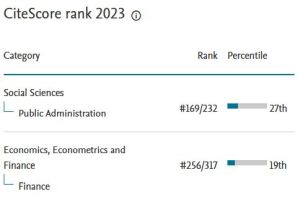Predicting Audit Quality: Systemic Issues and Predictive Modeling of PCAOB Inspections on European audit firms between 2013-2023
DOI:
https://doi.org/10.35551/PFQ_2025_1_4Keywords:
audit, audit quality, systemic audit issues, predictive modelling, PCAOB inspection reports, Europe, M42, H83Abstract
This study offers a comprehensive evaluation of Public Company Accounting Oversight Board (PCAOB) inspection reports concerning European audit firms over the period from 2013 to 2023. The research focuses on identifying systemic audit deficiencies and assessing the effectiveness of PCAOB-recommended interventions. By analyzing 120 inspection reports across several European countries, the study reveals pervasive issues in internal controls, particularly in areas such as revenue recognition, accounts receivable, and audit documentation. A mixed-methods approach is employed, combining multiple regression analysis and machine learning techniques to uncover significant predictors of these deficiencies, alongside qualitative insights that contextualize recurring problems. The findings highlight the complex, interrelated nature of audit processes and underscore the critical role of robust internal controls and adherence to PCAOB standards in enhancing audit quality. This research contributes to the literature by providing actionable recommendations for improving audit practices, thus offering valuable insights for regulators, policymakers, and audit professionals. The study’s implications extend to advancing regulatory effectiveness and ensuring higher standards of financial reporting in the European context.
References
Acito, A. A., Hogan, C. E., & Mergenthaler, R. D. (2018). The effects of PCAOB inspections on auditor-client relationships. The Accounting Review, 93(2), 1-35. https://doi.org/10.2308/accr-51811
Aobdia, D. (2018). The impact of the PCAOB individual engagement inspection process—Preliminary evidence. The Accounting Review, 93(4), 53-80. https://doi. org/10.2308/accr-51948
Aobdia, D. (2019). Do practitioner assessments agree with academic proxies for au-dit quality? Evidence from PCAOB and internal inspections. Journal of Accounting and Economics, 67(1), 144-174. https://doi.org/10.1016/j.jacceco.2018.09.001
Barlaup, K., Iren Drønen, H., & Stuart, I. (2009). Restoring trust in auditing: Et-hical discernment and the Adelphia scandal. Managerial Auditing Journal, 24(2), 183-203. https://doi.org/10.1108/02686900910924572
Baker, C. R., & Hayes, R. (2004). Reflecting form over substance: the case of En-ron Corp. Critical Perspectives on Accounting, 15(6-7), 767-785. https://doi.or-g/10.1016/j.cpa.2002.08.001
Bishop, C. C., Hermanson, D. R., & Houston, R. W. (2013). PCAOB inspections of international audit firms: Initial evidence. International Journal of Auditing, 17(1), 1-18. https://doi.org/10.1111/j.1099-1123.2012.00453.x
Brown-Liburd, H., Issa, H., & Lombardi, D. (2015). Behavioral implications of Big Data’s impact on audit judgment and decision making and future research direc-tions. Accounting horizons, 29(2), 451-468. https://doi.org/10.2308/acch-51023
Carcello, J. V., Hollingsworth, C., & Mastrolia, S. A. (2011). The effect of PCAOB inspections on Big 4 audit quality. Research in accounting regulation, 23(2), 85-96. https://doi.org/10.1016/j.racreg.2011.10.001
Church, B. K., & Shefchik, L. B. (2012). PCAOB inspections and large accounting firms. Accounting Horizons, 26(1), 43-63. https://doi.org/10.2308/acch-50077
DeFond, M. L. (2010). How should the auditors be audited? Comparing the PCA-OB inspections with the AICPA peer reviews. Journal of Accounting and Econom-ics, 49(1-2), 104-108. https://doi.org/10.1016/j.jacceco.2009.04.003
DeFond, M. L., & Lennox, C. S. (2017). Do PCAOB inspections improve the qua-lity of internal control audits?. Journal of Accounting Research, 55(3), 591-627. htt-ps://doi.org/10.1111/1475-679X.12151
Francis, J. R. (2011). A framework for understanding and researching au-dit quality. Auditing: A journal of practice & theory, 30(2), 125-152. https://doi. org/10.2308/ajpt-50006
Giroux, G. (2008). What Went Wrong?: Accounting Fraud and Lessons from the Recent Scandals. Social Research: An International Quarterly, 75(4), 1205-1238. https://dx.doi.org/10.1353/sor.2008.0026
Glover, S. M., Prawitt, D. F., & Taylor, M. H. (2009). Audit standard setting and inspection for US public companies: A critical assessment and recommenda-tions for fundamental change. Accounting Horizons, 23(2), 221-237. https://doi. org/10.2308/acch.2009.23.2.221
Gramling, A. A., Krishnan, J., & Zhang, Y. (2011). Are PCAOB-identified audit defi-ciencies associated with a change in reporting decisions of triennially inspected audit firms?. Auditing: A Journal of Practice & Theory, 30(3), 59-79 https://doi. org/10.2308/ajpt-10048
Johnson, L. M., Keune, M. B., & Winchel, J. (2019). US auditors’ perceptions of the PCAOB inspection process: A behavioral examination. Contemporary Accounting Research, 36(3), 1540-1574. https://doi.org/10.1111/1911-3846.12467
Kemmerer, C. H., & Shawver, T. J. (2007). Tyco: A top-down approach to ethical failure. Available at SSRN 1010558. https://dx.doi.org/10.2139/ssrn.1010558
Knechel, W. R., Krishnan, G. V., Pevzner, M., Shefchik, L. B., & Velury, U. K. (2013). Audit quality: Insights from the academic literature. Auditing: A journal of practice & theory, 32(Supplement 1), 385-421. https://doi.org/10.2308/ajpt-50350
Kukreja, G., & Gupta, S. (2016). Tesco Accounting Misstatements: Myopic Ideo-logies Overshadowing Larger Organisational Interests. SDMIMD Journal of Man-agement, 7(1). https://doi.org/10.18311/sdmimd/2016/8410
Mawutor, J. K. M. (2014). The failure of Lehman Brothers: causes, preventive measures and recommendations. Research Journal of Finance and Accounting, 5(4). https://dx.doi.org/10.2139/ssrn.2156006
Reeb, D. M., & Zhao, W. (2013). Director capital and corporate disclosure quality. Jour-nal of Accounting and Public Policy, 32(4), 191-212. https://doi.org/10.1016/j.jacc-pubpol.2012.11.003
Smith, W. L. (2013). Lessons of the HealthSouth fraud: An insider’s view. Issues in accounting education, 28(4), 901-912. https://doi.org/10.2308/iace-50542
Shroff, N. (2020). Real effects of PCAOB international inspections. The Account-ing Review, 95(5), 399-433. https://doi.org/10.2308/accr-52635
Schultz Jr, J. J., & Lopez, T. J. (2001). The impact of national influence on accoun-ting estimates: Implications for international accounting standard-setters. The International Journal of Accounting, 36(3), 271-290. https://doi.org/10.1016/S0020-7063(01)00103-0
Stefaniak, C. M., Houston, R. W., & Brandon, D. M. (2017). Investigating inspecti-on risk: An analysis of PCAOB inspections and internal quality reviews. Auditing: A Journal of Practice & Theory, 36(1), 151-168. https://doi.org/10.2308/ajpt-51518
Stuber, S. B., & Hogan, C. E. (2021). Do PCAOB inspections improve the accuracy of accounting estimates? Journal of Accounting Research, 59(1), 331-370. https://doi.org/10.1111/1475-679X.12339
Downloads
Published
How to Cite
Issue
Section
License
Copyright (c) 2025 Public Finance Quarterly

This work is licensed under a Creative Commons Attribution 4.0 International License.
Authors assign copyright to Pénzügyi Szemle / Public Finance Quarterly. Authors are responsible for permission to reproduce copyright material from other sources.











